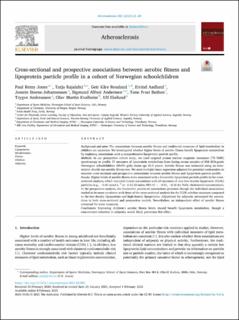| dc.contributor.author | Jones, Paul Remy | |
| dc.contributor.author | Rajalahti, Tarja | |
| dc.contributor.author | Resaland, Geir Kåre | |
| dc.contributor.author | Aadland, Eivind | |
| dc.contributor.author | Steene-Johannessen, Jostein | |
| dc.contributor.author | Anderssen, Sigmund Alfred | |
| dc.contributor.author | Bathen, Tone Frost | |
| dc.contributor.author | Andreassen, Trygve | |
| dc.contributor.author | Kvalheim, Olav Martin | |
| dc.contributor.author | Ekelund, Ulf | |
| dc.date.accessioned | 2021-08-03T09:59:30Z | |
| dc.date.available | 2021-08-03T09:59:30Z | |
| dc.date.created | 2021-02-18T17:06:10Z | |
| dc.date.issued | 2021 | |
| dc.identifier.issn | 0021-9150 | |
| dc.identifier.uri | https://hdl.handle.net/11250/2765982 | |
| dc.description.abstract | Background and aims
The associations between aerobic fitness and traditional measures of lipid metabolism in children are uncertain. We investigated whether higher levels of aerobic fitness benefit lipoprotein metabolism by exploring associations with a comprehensive lipoprotein particle profile.
Methods
In our prospective cohort study, we used targeted proton nuclear magnetic resonance (1H NMR) spectroscopy to profile 57 measures of lipoprotein metabolism from fasting serum samples of 858 fifth-grade Norwegian schoolchildren (49.0% girls; mean age 10.0 years). Aerobic fitness was measured using an intermittent shuttle run aerobic fitness test. We used multiple linear regression adjusted for potential confounders to examine cross-sectional and prospective associations between aerobic fitness and lipoprotein particle profile.
Results
Higher levels of aerobic fitness were associated with a favourable lipoprotein particle profile in the cross-sectional analysis, which included inverse associations with all measures of very low-density lipoprotein (VLDL) particles (e.g., −0.06 mmol·L−1 or –0.23 SD units; 95% CI = −0.31, −0.16 for VLDL cholesterol concentration). In the prospective analysis, the favourable pattern of associations persisted, though the individual associations tended to be more consistent with those of the cross-sectional analysis for the VLDL subclass measures compared to the low-density lipoproteins and high-density lipoproteins. Adjustment for adiposity attenuated the associations in both cross-sectional and prospective models. Nevertheless, an independent effect of aerobic fitness remained for some measures.
Conclusions
Improving children's aerobic fitness levels should benefit lipoprotein metabolism, though a concomitant reduction in adiposity would likely potentiate this effect. | en_US |
| dc.language.iso | eng | en_US |
| dc.publisher | Elsevier | en_US |
| dc.rights | Navngivelse 4.0 Internasjonal | * |
| dc.rights.uri | http://creativecommons.org/licenses/by/4.0/deed.no | * |
| dc.title | Cross-sectional and prospective associations between aerobic fitness and lipoprotein particle profile in a cohort of Norwegian schoolchildren | en_US |
| dc.type | Journal article | en_US |
| dc.type | Peer reviewed | en_US |
| dc.description.version | publishedVersion | en_US |
| dc.rights.holder | Copyright 2021 The Authors | en_US |
| cristin.ispublished | true | |
| cristin.fulltext | original | |
| cristin.qualitycode | 1 | |
| dc.identifier.doi | 10.1016/j.atherosclerosis.2021.02.002 | |
| dc.identifier.cristin | 1891508 | |
| dc.source.journal | Atherosclerosis | en_US |
| dc.source.pagenumber | 21-29 | en_US |
| dc.identifier.citation | Atherosclerosis. 2021, 321, 21-29. | en_US |
| dc.source.volume | 321 | en_US |

